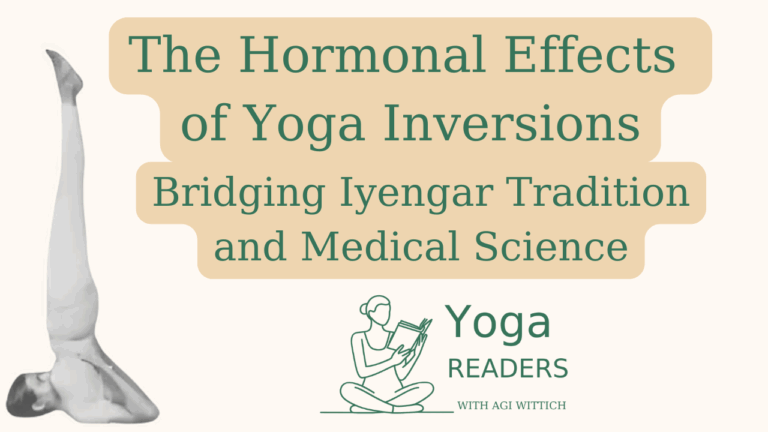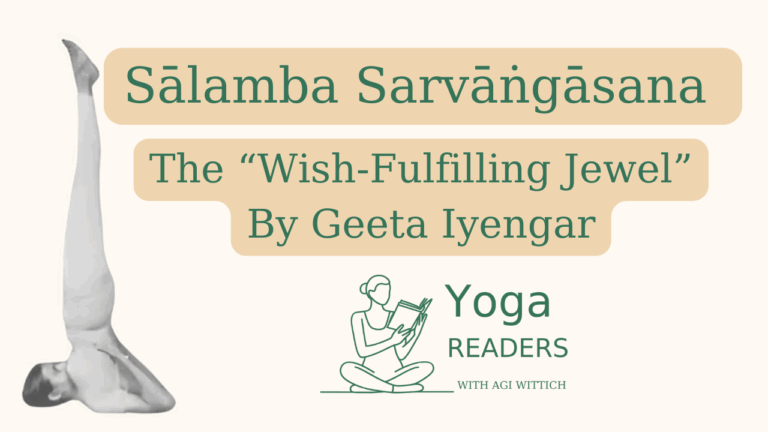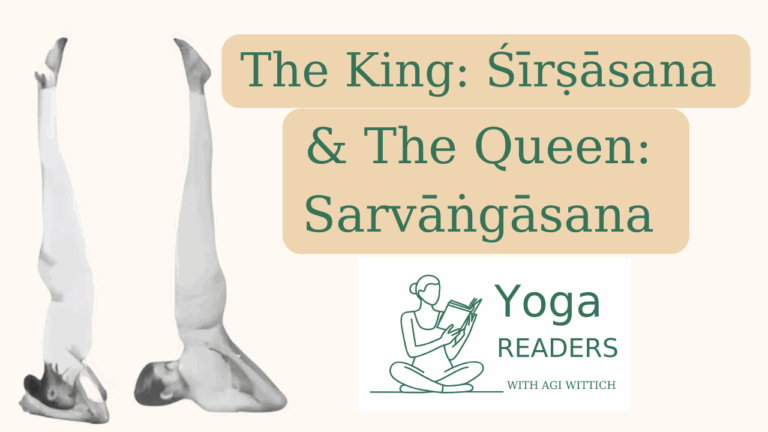
The Hormonal Effects of Yoga Inversions: Bridging Iyengar Tradition and Medical Science
Within the rich tradition of Iyengar Yoga, Śīrṣāsana (Headstand, a posture where
| Reading Unit 5 includes III Sitting and Supine Asana, IV Inverted Asanas, V Abdominal and Lumbar Asanas |
.
Unit 5 marks a pivotal transition in Geeta Iyengar’s “Yoga: A Gem for Women,” moving from external practices to internal cultivation. This section encompasses three major categories of asanas: seated postures (Section III), inversions (Section IV), and abdominal work (Section V). Together, these practices form what Geeta calls the foundation for pranayama, concentration, and meditation—the essential stepping stones toward spiritual realization. Unlike standing postures which ground and strengthen, these practices specifically prepare practitioners for the subtler aspects of yoga. Geeta frames them not merely as physical exercises but as “sacred technologies” that facilitate the journey from external awareness to internal transformation.
Section III: Seated and Supine Postures – The Sacred Foundation
Geeta opens this section with profound clarity: “The asanas described in this section prepare the body and the mind for pranayama which leads one further in one’s spiritual life.” This statement elevates seated postures from physical practice to spiritual methodology, establishing their role as vehicles for psychological and spiritual development.
She emphasizes that seated postures are “necessary for a firm foundation in breath control, concentration and meditation, which lead one towards Samadhi (self-realization).” The connection between physical steadiness and mental clarity becomes explicit: “They bring firmness of body and steadiness of mind, without which self-realization is impossible.”
Section IV: Inversions – The Royal Family of Asanas
Geeta introduces inversions with one of her most beautiful metaphors: they “can be compared to our parents who help us, guide us, and make our lives a success.” This familial framing transforms our relationship with these challenging poses from conquest to nurturing, from achievement to receiving guidance.
Section V: Abdominal Work – Strength with Caution
Geeta establishes clear prerequisites for abdominal work: “If the abdominal muscles and the muscles of the lumbar are weak, the asanas given in this section are too intensive to be attempted immediately.” This reflects her systematic approach—standing postures, forward bends, and seated postures must be established before attempting intensive abdominal work.
Unit 5 of “Yoga: A Gem for Women” represents more than technical instruction—it offers a complete methodology for transitioning from external to internal practice. Geeta’s integration of ancient wisdom with compassionate innovation creates what can truly be called “sacred technologies”—precise methods for physical, mental, and spiritual transformation that honor both tradition and individual needs.
Her vision of postures as vehicles for psychological and spiritual development, combined with her revolutionary accessibility modifications, established principles that continue to influence yoga instruction worldwide. The unit demonstrates that advanced practice is not about perfect physical achievement but about the systematic cultivation of stability, clarity, and inner awareness—regardless of one’s starting point or physical limitations.
Most significantly, this unit embodies Geeta’s central teaching: that yoga must be both aspirational and accessible, both challenging and compassionate. Every modification, every alternative technique, every gentle progression serves not as a compromise but as a pathway—ensuring that the transformative technologies of yoga remain available to every practitioner, every body, every sincere seeker on the path toward self-realization.
1. How does the text explain the relationship between inversions and emotional stability?
2. What is the significance of twisting poses for women’s health?
3. How does the text balance encouraging practice with ensuring safety?
In our last Yoga Readers session, we journeyed through one of the most transformative sections of Geeta Iyengar’s masterwork – the transition from external to internal practice through seated postures and inversions. What emerged was not just technical instruction, but a profound understanding of how physical practice becomes a vehicle for spiritual development.
The Sacred Technology of Seated Postures
Geeta begins this section with a revolutionary premise: these postures “prepare the body and the mind for pranayama which leads one further in one’s spiritual life.” This framing immediately elevates what might be seen as mere physical exercises into what I call “sacred technologies” – precise methods for inner transformation.
Her approach to the ancient debate between Siddhasana and Padmasana is particularly striking. While traditional texts often argued vehemently for one over the other, Geeta simply states both are sacred, both are valuable. This reflects her deeper philosophy of meeting practitioners where they are rather than demanding rigid adherence to classical forms.
Compassion in Action
What makes Geeta’s instructions truly revolutionary is her consistent attention to accessibility. When she writes, “If you find it difficult to straighten the spine, keep a folded blanket under the buttocks,” we must remember this was written in the 1970s when such modifications were unheard of. Her systematic approach – use support when needed, reduce gradually – became the foundation of modern therapeutic yoga.
Even more touching is her acknowledgment that you can “read or knit” in these positions. This isn’t diminishing the sacredness of practice; it’s recognizing that yoga can be woven into daily life, especially for women managing family responsibilities.
Inversions as Family: The Royal Court of Asanas
Perhaps nowhere is Geeta’s poetic wisdom more evident than in her treatment of inversions. Comparing Sirsasana and Sarvangasana to parents “who help us, guide us, and make our lives a success” transforms our relationship with these challenging poses from conquest to nurturing.
Her gendered descriptions – Sirsasana developing “manly qualities of willpower” while Sarvangasana cultivates “feminine qualities of patience and emotional stability” – reflect both traditional understanding and her woman-centered approach. Regardless of gender, we all need both qualities in our practice and lives.
The Queen’s Crown: Sarvangasana as Trilokya Chintamani
The description of Sarvangasana as “Trilokya Chintamani – a rare gem among the three worlds” reveals Geeta’s deep connection to yogic poetry. This isn’t just anatomical instruction; it’s an invitation to experience the pose as sacred space.
Her detailed modifications – blankets for shoulder support, chairs for accessibility, ropes for assistance – demonstrate that the “queen of asanas” should be available to all bodies, not just those who can achieve the classical form.
Beyond Physical: The Therapeutic Revolution
Throughout this section, Geeta weaves together ancient wisdom and practical therapeutics. Her specific recommendations for menstrual disorders, menopause symptoms, and emotional instability were groundbreaking for their time and remain relevant today. The research I’ve conducted on hormonal effects of inversions confirms much of what Geeta intuited – these poses do create measurable physiological changes. But her genius lies in connecting the physical benefits to the spiritual journey, never separating body from mind from soul.

Within the rich tradition of Iyengar Yoga, Śīrṣāsana (Headstand, a posture where

Understanding Geeta Iyengar’s Profound Vision of the Shoulderstand When most yoga practitioners

In the vast repertoire of yoga asanas, two poses stand as pillars
“Writing, Practice, and the Evolution of Iyengar Yoga for Women” This session…
What a joy it was to connect with so many of you…
Reading Unit 1 includes the Forwards, Preface, I First Steps in Yoga,…
Reading Unit 2 includes IV Are Women Eligible for Yoga?, V The…
A Special Session with N. Sine Ozsoy This talk will provide a…
Reading Unit 3 includes VIII Know Your Body, IX Yoga Sadhana, X…
Reading Unit 4 includes I: Standing asana, II: Forward Bends Chapter Summary…
A special exploration for the Yoga Readers community Join a unique session…
Reading Unit 5 includes III Sitting and Supine Asana, IV Inverted Asanas,…
Reading Unit 6 includes VI Asanas: Twists, VII Asanas: Backbends, VIII Asanas:…
Reading Unit 7 includes IX Pregnancy Asanas and Pranayama & X Advanced…
Unit 8 includes XIII On the Threshold of Peace, XIV Hints and…